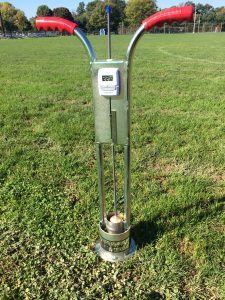From the desk of Dr Raudenbush:
Considering the deluge of rainfall in northeastern Ohio, we felt it was appropriate to post about drainage. In Ohio, our heavy soils are very susceptible to compaction, which can lead to playability and safety issues on golf courses and sports fields. Consequently, most golf course putting greens and professional/collegiate sports fields utilize sand-based rootzones, which are inherently resistant to compaction and have the ability to move large volumes of water through the soil profile. However, it is important to note that the performance of these surfaces can diminish over time.
A decline in sand-based rootzone performance could be due to variety of edaphic or environmental conditions, but turfgrass managers need to pay particular attention to top 1-4 inches of the soil profile. This is easier said than done, because almost all of our cultural practices (e.g. irrigation, fertilization, cultivation, topdressing, mowing) are going to affect how the upper soil profile changes over time; specifically, the accumulation of thatch and organic matter. Significant increases in thatch and organic matter can be highly detrimental to the performance and longevity of these surfaces, hence, why turfgrass managers often submit samples to local laboratories for loss-on-ignition testing. Results from these tests can provide invaluable feedback about organic matter accumulation and rootzone health, but they may not tell the whole story.
The superior drainage capabilities sand-based rootzones could be negated if low infiltration rates exist at the soil surface. Infiltration is the process by which external water enters the soil, and is expressed as a rate – typically as inches of water per hour (in/hr). High organic matter accumulation (> 4%) can reduce infiltration and increase water retention rates in sand-based rootzones, but these conditions can occur even when organic matter percentages are considered acceptable. For instance, frequent topdressing programs help maintain consistent organic matter percentages in putting greens from year to year; however, changes in the particle size distribution of your topdressing material can result in the formation of layers that may be detrimental to infiltration – this will not be reflected in an organic matter test. Similarly, sports field managers may elect to re-grass sand-based rootzones with sod grown in fine textured soils, which can create a perched water table at the soil surface. Both of these scenarios can reduce infiltration rates, often leading to spongy conditions following irrigation or rainfall events.
There are several methods for testing soil infiltration rates, and turfgrass managers need to be aware of the tradeoffs. This article does a great job highlighting the main differences between the infiltration methods, and should be read before deciding to conduct infiltration tests on your property.
Sports turf managers and superintendents managing sand-based rootzones need to ensure water can readily enter the soil surface. Excessive organic matter accumulation or soil layering will often reduce infiltration rates, resulting in spongy conditions that can increase the incidence of scalping, disease, and divoting. Turfgrass managers should use infiltration test results to help guide cultivation and topdressing programs. Lastly, infiltration rate testing requires specialized equipment and a thorough understanding of soil physics – tests should be conducted by a trusted industry expert or university specialist.
